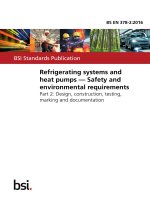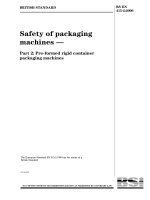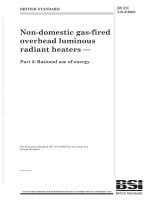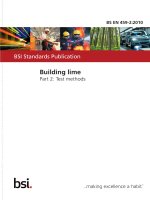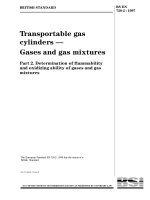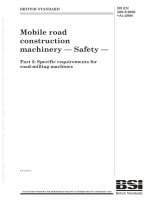Bsi bs en 50600 2 2 2014
Bạn đang xem bản rút gọn của tài liệu. Xem và tải ngay bản đầy đủ của tài liệu tại đây (2.36 MB, 40 trang )
BS EN 50600-2-2:2014
BSI Standards Publication
Information technology Data centre facilities and
infrastructures Part 2-2: Power distribution
BS EN 50600-2-2:2014
PUBLISHED DOCUMENT
National foreword
This British Standard is the UK implementation of EN 50600-2-2:2014.
The UK participation in its preparation was entrusted to Technical
Committee TCT/7, Telecommunications – Installation requirements.
A list of organizations represented on this committee can be obtained on
request to its secretary.
This publication does not purport to include all the necessary provisions of
a contract. Users are responsible for its correct application.
© The British Standards Institution 2014.
Published by BSI Standards Limited 2014
ISBN 978 0 580 74650 5
ICS 35.020; 35.110; 91.140.50
Compliance with a British Standard cannot confer immunity from
legal obligations.
This Published Document was published under the authority of the
Standards Policy and Strategy Committee on 30 April 2014.
Amendments/corrigenda issued since publication
Date
Text affected
BS EN 50600-2-2:2014
EUROPEAN STANDARD
EN 50600-2-2
NORME EUROPÉENNE
EUROPÄISCHE NORM
March 2014
ICS 35.020; 35.110; 91.140.50
English version
Information technology Data centre facilities and infrastructures Part 2-2: Power distribution
Informationstechnik Einrichtungen und Infrastrukturen von
Rechenzentren Teil 2-2: Stromversorgung
This European Standard was approved by CENELEC on 2014-01-06. CENELEC members are bound to
comply with the CEN/CENELEC Internal Regulations which stipulate the conditions for giving this European
Standard the status of a national standard without any alteration.
Up-to-date lists and bibliographical references concerning such national standards may be obtained on
application to the CEN-CENELEC Management Centre or to any CENELEC member.
This European Standard exists in three official versions (English, French, German). A version in any other
language made by translation under the responsibility of a CENELEC member into its own language and
notified to the CEN-CENELEC Management Centre has the same status as the official versions.
CENELEC members are the national electrotechnical committees of Austria, Belgium, Bulgaria, Croatia,
Cyprus, the Czech Republic, Denmark, Estonia, Finland, Former Yugoslav Republic of Macedonia, France,
Germany, Greece, Hungary, Iceland, Ireland, Italy, Latvia, Lithuania, Luxembourg, Malta, the Netherlands,
Norway, Poland, Portugal, Romania, Slovakia, Slovenia, Spain, Sweden, Switzerland, Turkey and the United
Kingdom.
CENELEC
European Committee for Electrotechnical Standardization
Comité Européen de Normalisation Electrotechnique
Europäisches Komitee für Elektrotechnische Normung
CEN-CENELEC Management Centre: Avenue Marnix 17, B - 1000 Brussels
© 2014 CENELEC -
All rights of exploitation in any form and by any means reserved worldwide for CENELEC members.
Ref. No. EN 50600-2-2:2014 E
BS EN 50600-2-2:2014
EN 50600-2-2:2014
Contents
Foreword ......................................................................................................................................................4
Introduction ..................................................................................................................................................5
1
Scope .................................................................................................................................................. 7
2
Normative references........................................................................................................................ 7
3
Terms, definitions and abbreviations ............................................................................................. 8
3.1
Terms and definitions ....................................................................................................................... 8
3.2
Abbreviations ................................................................................................................................... 11
4
Conformance ................................................................................................................................... 12
5
Power supply and distribution within data centres ..................................................................... 12
5.1
General.............................................................................................................................................. 12
5.2
Dimensioning of power distribution systems............................................................................... 15
6
Availability ....................................................................................................................................... 15
6.1
General requirements ...................................................................................................................... 15
6.2
Power supply ................................................................................................................................... 16
6.3
Power distribution ........................................................................................................................... 24
6.4
Incorporation of LVDC distribution ............................................................................................... 28
6.5
Additional considerations............................................................................................................... 28
6.6
Emergency Power Off (EPO) .......................................................................................................... 28
7
Physical security ............................................................................................................................. 29
7.1
General.............................................................................................................................................. 29
7.2
Access .............................................................................................................................................. 29
7.3
Internal environmental events ........................................................................................................ 29
7.4
External environmental events ...................................................................................................... 30
8
Energy efficiency enablement and power distribution ............................................................... 30
8.1
General.............................................................................................................................................. 30
8.2
Granularity Level 1 .......................................................................................................................... 31
8.3
Granularity Level 2 .......................................................................................................................... 31
8.4
Granularity Level 3 .......................................................................................................................... 31
8.5
Cabling infrastructure to support energy efficiency enablement............................................... 32
Annex A (informative) Example implementations of power distribution ............................................. 33
A.1
Symbology........................................................................................................................................ 33
BS EN 50600-2-2:2014
EN 50600-2-2:2014
A.2
Example implementations .............................................................................................................. 33
Bibliography .............................................................................................................................................. 36
Figures
Figure 1 — Schematic relationship between the EN 50600 standards .................................................. 6
Figure 2 — Power supply functional elements ...................................................................................... 13
Figure 3 —Secondary and tertiary power distribution systems ........................................................... 14
Figure 4 — Example of single path solution for power supply ............................................................ 21
Figure 5 — Example of “single path resilient” solution for power supply .......................................... 22
Figure 6 — Example of “multi-path resilience with concurrent repair/operate” solution for power
supply ......................................................................................................................................................... 22
Figure 7 — Example of fault tolerant design solution for power supply ............................................. 23
Figure 8 — Example of single path solution for power distribution .................................................... 27
Figure 9 — Example of “single path resilient” solution for power distribution .................................. 27
Figure 10 — Example of “multi-path resilience with concurrent repair/operate” solution for power
distribution ................................................................................................................................................. 27
Figure 11 — Example of fault tolerant design solution for power distribution................................... 28
Figure 12 — Possible measurement points ............................................................................................ 30
Figure A.1 — Example for a Class 1/Class 2 power distribution .......................................................... 34
Figure A.2 — Example for a Class 3/Class 4 power distribution .......................................................... 35
Tables
Table 1 — Functional elements of power distribution ........................................................................... 13
BS EN 50600-2-2:2014
EN 50600-2-2:2014
Foreword
This document (EN 50600-2-2:2014) has been prepared by CLC/TC 215 “Electrotechnical aspects of
telecommunication equipment”.
The following dates are fixed:
•
•
latest date by which this document has
to be implemented at national level by
publication of an identical national
standard or by endorsement
latest date by which the national
standards conflicting with this
document have to be withdrawn
(dop)
2015-01-06
(dow)
2015-01-06
Attention is drawn to the possibility that some of the elements of this document may be the subject of
patent rights. CENELEC [and/or CEN] shall not be held responsible for identifying any or all such patent
rights.
This document has been prepared under a mandate given to CENELEC by the European Commission
and the European Free Trade Association.
BS EN 50600-2-2:2014
EN 50600-2-2:2014
Introduction
The unrestricted access to internet-based information demanded by the information society has led to an
exponential growth of both internet traffic and the volume of stored/retrieved data. Data centres are
housing and supporting the information technology and network telecommunications equipment for data
processing, data storage and data transport. They are required both by network operators (delivering
those services to customer premises) and by enterprises within those customer premises.
Data centres need to provide modular, scalable and flexible facilities and infrastructures to easily
accommodate the rapidly changing requirements of the market. In addition, energy consumption of data
centres has become critical both from an environmental point of view (reduction of carbon footprint) and
with respect to economical considerations (cost of energy) for the data centre operator.
The implementation of data centres varies in terms of:
a)
purpose (enterprise, co-location, co-hosting, or network operator facilities);
b)
security level;
c)
physical size;
d)
accommodation (mobile, temporary and permanent constructions).
The needs of data centres also vary in terms of availability of service, the provision of security and the
objectives for energy efficiency. These needs and objectives influence the design of data centres in terms
of building construction, power distribution, environmental control and physical security. Effective
management and operational information is required to monitor achievement of the defined needs and
objectives.
This series of European Standards specifies requirements and recommendations to support the various
parties involved in the design, planning, procurement, integration, installation, operation and maintenance
of facilities and infrastructures within data centres. These parties include:
1)
owners, facility managers, ICT managers, project managers, main contractors;
2)
consultants, architects, building designers and builders, system and installation designers;
3)
facility and infrastructure integrators, suppliers of equipment;
4)
installers, maintainers.
At the time of publication of this European Standard, EN 50600 series will comprise the following
standards:
EN 50600-1: Information technology — Data centre facilities and infrastructures — Part 1: General
concepts;
EN 50600-2-1: Information technology — Data centre facilities and infrastructures — Part 2-1: Building
construction;
EN 50600-2-2: Information technology — Data centre facilities and infrastructures — Part 2-2: Power
distribution;
EN 50600-2-3: Information technology — Data centre facilities and infrastructures — Part 2-3:
Environmental control;
BS EN 50600-2-2:2014
EN 50600-2-2:2014
EN 50600-2-4: Information technology — Data centre facilities and infrastructures — Part 2-4:
Telecommunications cabling infrastructure;
EN 50600-2-5: Information technology — Data centre facilities and infrastructures — Part 2-5: Security
systems;
EN 50600-2-6: Information technology — Data centre facilities and infrastructures — Part 2-6:
Management and operational information.
The inter-relationship of the standards within the EN 50600 series is shown in Figure 1.
EN 50600-2-1
Building construction
EN 50600-2-2
Power distribution
EN 50600-1
General concepts
EN 50600-2-3
Environmental control
EN 50600-2-4
Telecommunications
cabling infrastructure
EN 50600-2-5
Security systems
EN 50600-2-6
Management and
operational information
Figure 1 — Schematic relationship between the EN 50600 standards
EN 50600-2-X standards specify requirements and recommendations for particular facilities and
infrastructures to support the relevant classification for “availability”, “physical security” and “energy
efficiency enablement” selected from EN 50600-1.
This European Standard addresses facilities and infrastructures for power supplies to, and power
distribution within, data centres together with the interfaces for monitoring the performance of those
facilities and infrastructures in line with EN 50600-2-6 (in accordance with the requirements of
EN 50600-1). The line diagrams used in certain figures are not intended to replace the more familiar
electrical circuit diagrams associated with power supply and distribution systems which are included
where relevant.
This European Standard is intended for use by and collaboration between architects, building designers
and builders, system and installation designers.
This series of European Standards does not address the selection of information technology and network
telecommunications equipment, software and associated configuration issues.
BS EN 50600-2-2:2014
EN 50600-2-2:2014
1 Scope
This European Standard addresses power supplies to, and power distribution within, data centres based
upon the criteria and classifications for “availability”, “physical security” and “energy efficiency
enablement” within EN 50600-1.
This European Standard specifies requirements and recommendations for the following:
a)
power supplies to data centres;
b)
power distribution systems within data centres;
c)
facilities for both normal and emergency lighting;
d)
equipotential bonding and earthing;
e)
lightning protection;
f)
devices for the measurement of the power consumption characteristics at points along the power
distribution system and their integration within management tools.
Safety and electromagnetic compatibility (EMC) requirements are outside the scope of this European
Standard and are covered by other standards and regulations. However, information given in this
European Standard may be of assistance in meeting these standards and regulations.
Conformance of data centres to the present document is covered in Clause 4.
2 Normative references
The following documents, in whole or in part, are normatively referenced in this document and are
indispensable for its application. For dated references, only the edition cited applies. For undated
references, the latest edition of the referenced document (including any amendments) applies.
EN 50160:2010, Voltage characteristics of electricity supplied by public electricity networks
EN 50174-2, Information technology – Cabling installation – Part 2: Installation planning and practices
inside buildings
EN 50174-3, Information technology – Cabling installation – Part 3: Installation planning and practices
outside buildings
EN 50310, Application of equipotential bonding and earthing in buildings with information technology
equipment
EN 50600-1, Information technology – Data centre facilities and infrastructures – Part 1: General
concepts
EN 50600-2-1, Information technology – Data centre facilities and infrastructures – Part 2-1: Building
construction
EN 50600-2-3 1), Information technology – Data centre facilities and infrastructures – Part 2-3:
Environmental control
1) Draft for formal vote under preparation.
BS EN 50600-2-2:2014
EN 50600-2-2:2014
EN 50600-2-4 2), Information technology – Data centre facilities and infrastructures – Part 2-4:
Telecommunications cabling infrastructure
EN 50600-2-5 3), Information technology – Data centre facilities and infrastructures – Part 2-5: Security
systems
EN 60044-1:1999, Instrument transformers – Part 1: Current transformers (IEC 60044-1:1996, modified)
EN 60947 (all parts), Low-voltage switchgear and controlgear (IEC 60947, all parts)
EN 61000-2-4:2002, Electromagnetic compatibility (EMC) – Part 2-4: Environment – Compatibility levels
in industrial plants for low-frequency conducted disturbances (IEC 61000-2-4:2002)
EN 61439 (all parts), Low-voltage switchgear and controlgear assemblies (IEC 61439, all parts)
EN 62040 (all parts), Uninterruptible power systems (UPS) (IEC 62040, all parts)
EN 62305 (all parts), Protection against lightning (IEC 62305, all parts)
EN 62305-4, Protection against lightning – Part 4: Electrical and electronic systems within structures
(IEC 62305-4)
EN 88528-11, Reciprocating internal combustion engine driven alternating current generating sets –
Part 11: Rotary uninterruptible power systems – Performance requirements and test methods
(IEC 88528-11)
3 Terms, definitions and abbreviations
3.1 Terms and definitions
For the purposes of this document, the terms and definitions given in EN 50600-1 and the following apply.
3.1.1
active power
real power
product of r.m.s. voltage, r.m.s. current and power factor (expressed as W)
3.1.2
additional supply
backup supply
power supply that provides power in the event of failure of primary and/or secondary supply
3.1.3
apparent power
product of r.m.s. voltage and r.m.s current (expressed as VA)
3.1.4
capacitive load
load that is capacitive, so that the alternating current is out of phase with and leads the voltage
3.1.5
catenary
wire hung at a specific tension between supporting structures of power cabling
2) Circulated for CENELEC enquiry.
3) Draft for CENELEC enquiry under preparation.
BS EN 50600-2-2:2014
EN 50600-2-2:2014
3.1.6
diverse route
alternative, separate, pathway intended to provide adequate segregation from another pathway, in order
to provide resilient service provision in the event of physical damage to one of the pathways
3.1.7
emergency power off
designated device to provide emergency switching which disconnects power from one or more data
centre facilities, infrastructures or spaces
Note 1 to entry:
regulations.
The configuration and function of emergency power off devices may be subject to national or local
3.1.8
fire compartment
discrete zone designed to contain a fire within that zone
3.1.9
high voltage
voltage whose nominal r.m.s. value is 36 kV < Un ≤ 150 kV
Note 1 to entry:
be different.
Because of existing network structures, in some countries the boundary between MV and HV can
[SOURCE: EN 50160:2010, 3.7]
3.1.10
inductive load
load that is inductive, so that the alternating current is out of phase with and lags behind the voltage
3.1.11
information technology equipment
equipment providing data storage, processing and transport services together with equipment dedicated
to providing direct connection to core and/or access networks
3.1.12
IT load
electrical consumption of all the information technology equipment measured at its input terminals
including all on-board integrated power supplies and cooling fans
3.1.13
load factor
ratio of the average load to the peak load over a period of time
3.1.14
locally protected supply provision
sockets which continue to deliver power to connected equipment for a defined period following failure of
power supply and distribution equipment by means of a battery supply or UPS adjacent to, or co-located
with, those sockets (e.g. emergency lighting)
3.1.15
low voltage
voltage whose nominal r.m.s. value is Un ≤ 1 kV
[SOURCE: EN 50160:2010, 3.9]
3.1.16
mechanical cooling load
electrical consumption of all the plant and components used to provide environmental control within the
data centre, generally comprising compressors, controls, fans, pumps and humidifiers
BS EN 50600-2-2:2014
EN 50600-2-2:2014
3.1.17
medium voltage
voltage whose nominal r.m.s. value is 1 kV < Un ≤ 36 kV
Note 1 to entry:
be different.
Because of existing network structures, in some countries the boundary between MV and HV can
[SOURCE: EN 50160:2010, 3.11]
3.1.18
pathway
defined route for cables between termination points
[SOURCE: EN 50174-1:2009/A1:2011, 3.1.26]
3.1.19
power factor
under periodic conditions, ratio of the absolute value of the active power P to the apparent power
S: λ = |P|/S
Note 1 to entry: The ratio of the active (real) power flowing to the load to the apparent power (as a result of the
capacitive or inductive nature of the load) and is a dimensionless number between 0 and 1.
[SOURCE: IEC 60050-131:2002, 131-11-46, modified]
3.1.20
protected supply provision
no break protected supply provision
sockets which continue to deliver power to connected equipment for a defined period following failure of
power supply and distribution equipment
3.1.21
primary distribution equipment
equipment which is required to manage, control and convert incoming power supplies (primary,
secondary and, where appropriate, additional) in a form suitable for distribution by secondary distribution
equipment
3.1.22
primary supply
principal power supply that provides power to the data centre under normal operating conditions
3.1.23
resistive load
load in which the alternating current is in phase with the voltage
Note 1 to entry:
The total reactance is zero.
3.1.24
secondary distribution equipment
equipment which is required to manage, control and distribute the power provided by the primary
distribution equipment to the short-break and unprotected sockets within the data centre and to the
tertiary distribution equipment
Note 1 to entry: The power supply may be single-phase AC, three-phase AC or DC. If there is a change from 3phase to 1-phase supply, this is generally achieved at the secondary distribution equipment that is served directly
from the primary distribution equipment.
BS EN 50600-2-2:2014
EN 50600-2-2:2014
3.1.25
secondary supply
power supply that provides power to the data centre in conjunction with the primary supply under normal
operating conditions
3.1.26
short-break supply provision
back-up supported supply provision
sockets which, upon failure of power supply and distribution equipment, will be provided with power from
an additional power supply after a defined period
3.1.27
socket
connection enabling supply of power to attached equipment
Note 1 to entry:
This may be a de-mateable or a hardwired connection.
3.1.28
tertiary distribution equipment
power supply equipment, typically accommodated within the cabinets, frames and racks of the data
centre spaces, which directly feeds the protected sockets therein
3.1.29
total harmonic current distortion
measurement of the harmonic distortion present on a current level, defined as the ratio of the sum of the
powers of all harmonic components to the power of the fundamental frequency
3.1.30
total harmonic voltage distortion
measurement of the harmonic distortion present on a voltage level, defined as the ratio of the sum of the
powers of all harmonic components to the power of the fundamental frequency
3.1.31
unprotected supply provision
sockets which fail to deliver power to connected equipment following failure in power supply and
distribution equipment
3.2 Abbreviations
For the purposes of this document, the abbreviations given in EN 50600-1 and the following apply.
AC
Alternating Current
DC, dc
Direct Current
EPO
Emergency Power Off
HV
High Voltage
ITE
Information technology equipment
LV
Low Voltage
MV
Medium Voltage
r.m.s.
root mean square
SPD
Surge Protective Device
BS EN 50600-2-2:2014
EN 50600-2-2:2014
THCD
Total Harmonic Current Distortion
THVD
Total Harmonic Voltage Distortion
TVSS
Transient Voltage Surge Suppression
UPS
Uninterruptible Power Supply
4 Conformance
For a data centre to conform to this European Standard:
a)
it shall feature a power supply and distribution design solution that meets the required Availability
Class of Clause 6 (and is predicted to meet the relevant availability requirements of that clause);
b)
the environmental controls applied to the spaces accommodating the power supply and distribution
system within the premises and serving the data centre shall be in accordance with EN 50600-2-3;
c)
it shall feature an approach to physical security in relation to the power supply and distribution
solution that meets the requirements of Clause 7;
d)
it shall feature an energy efficiency enablement solution that meets the requirements of the relevant
Granularity Level of Clause 8;
e)
the equipotential bonding system within the data centre shall be in accordance with the local mesh
earthing requirements of EN 50310;
f)
where lightning protection is required, it shall be in accordance with the EN 62305 series applied with
reference to EN 50310;
g)
local regulations, including safety, shall be met.
5 Power supply and distribution within data centres
5.1 General
The distribution of electrical power is one of the most important aspects of data centre infrastructure.
Disturbances of power supply voltage, current and frequency have a direct effect on the operational
safety of the data centre infrastructure and its availability.
The functional elements of power supply to and distribution within data centres are described in Table 1.
The requirements and recommendations for the provision of physical security to the spaces
accommodating the functional elements are described in Clause 7.
The primary and secondary supplies are typically provided from a transformer which may either be:
a)
within the premises containing the data centre (and may be owned by either the utility or the data
centre premises owner) or
b)
external and owned by the utility (and not considered to be a functional element).
The primary and secondary distribution equipment may also contain transformers.
The supply area is shown schematically in Figure 2 and indicates two implementations. The upper
diagram shows the minimum implementation comprising a primary power supply only. The lower diagram
BS EN 50600-2-2:2014
EN 50600-2-2:2014
includes a secondary supply and also and additionally supply that provides power to relevant equipment
in the data centre, if required, following a failure of the primary and/or secondary power supply.
Table 1 — Functional elements of power distribution
Area
Functional element
Typical accommodation
(using spaces of EN 50600–1)
Primary supply
Transformer space
Secondary supply
Supply
Supply transfer equipment (where multiple
supplies exists)
Electrical space
Additional supply (e.g. generator,
uninterruptible power supplies)
Generator space or electrical space
Primary distribution equipment
Electrical distribution space
Transformer space (if required)
Distribution
Uninterruptible power supplies (UPS)
Electrical space (or computer room space)
Secondary distribution equipment
Electrical space (but also present in many
other areas)
Transformer space (if required)
Tertiary distribution equipment
Computer room spaces or spaces requiring
provision of protected supplies
Primary
supply
Primary
distribution
equipment
Secondary
distribution
equipment
Primary
distribution
equipment
Secondary
distribution
equipment
Primary
supply
Secondary
supply
Additional supply
Supply transfer
switchgear
Figure 2 — Power supply functional elements
The primary distribution equipment provides the interface between the supply and distribution areas.
The input to the primary distribution equipment may be LV and/or MV.
The output from the primary distribution equipment may be LV and/or MV depending upon the size of the
premises and the input requirements of any UPS or DC supply equipment installed between the primary
and secondary distribution equipment.
The input to the secondary distribution equipment may be LV and/or MV.
BS EN 50600-2-2:2014
EN 50600-2-2:2014
The distribution area is shown in Figure 3. The power is distributed via one or more instances of
secondary distribution equipment. These and subsequent figures adopt a system level approach to the
implementation. Examples of specific implementations are shown in Annex A using symbols more familiar
to those of the electrical design and installation field.
Within Figure 3 the power is provided to sockets in the distribution area that are categorised as:
1)
unprotected sockets - suitable for equipment that is not critical to the function of the data centre (e.g.
normal lighting and powering of tools and equipment required for the maintenance of the facility);
2)
protected sockets - intended for equipment (e.g. data processing, storage and transport equipment)
that is critical to the function of the data centre and which cannot tolerate failure of supply, served by
solutions including uninterruptible power supplies (UPS) installed as part of the distribution system;
3)
locally protected sockets - intended for equipment (e.g. emergency lighting) served by solutions
including uninterruptible power supplies (UPS) or local battery supplies installed at or close to the
socket);
4)
short-break sockets (available where the primary and/or secondary power supply is augmented with
an additional supply) - intended for equipment (e.g. environmental control equipment) that is critical
to the function of the data centre but which can tolerate a failure of supply for a short period before
the additional supply (e.g. generator) is brought into service.
Unprotected, locally protected and short-break sockets are fed directly by the secondary distribution
equipment. The output from the secondary distribution equipment is assumed to be LV. Additional
secondary distribution equipment is typically installed where there is a need to change the current
capacity of the power supply cabling.
The protected sockets are fed by tertiary distribution equipment which feeds stand-alone and cabinet,
frame or rack mounted equipment. The tertiary distribution equipment enables the monitoring of the IT
load as described in 8.4.
Secondary
distribution
equipment
Additional secondary
distribution equipment
(if required)
Unprotected
socket
Primary distribution
equipment
UPS
or
DC supply
Tertiary distribution
equipment
Local battery
supply/UPS
Locally protected
socket
Short-break
socket
Available if
primary distribution
equipment is fed by
additional supply
Figure 3 —Secondary and tertiary power distribution systems
Protected
socket
BS EN 50600-2-2:2014
EN 50600-2-2:2014
5.2 Dimensioning of power distribution systems
In small data centres, the data centre may only contain the functional elements within the distribution area
(the primary distribution equipment being elsewhere in the premises and serving the power distribution in
the remainder of the premises). In large data centres, primary distribution equipment may be dedicated to
the demands of the data centre itself.
The smallest data centres may comprise a single cabinet containing in-cabinet distribution equipment
providing protected power supplies to data processing, storage and transport equipment. In such cases
the functionality of the secondary distribution equipment may be provided by the in-cabinet distribution
equipment. It may not be necessary to provide any unprotected or short-break power supplies within the
cabinet.
In the small data centres comprising a limited number of cabinets, frames or racks, the UPS equipment
may be installed immediately prior to, or within, the tertiary distribution area.
As data centres grow either physically and/or in terms of their importance to the business they support,
the most obvious additional element is the provision of an additional supply as shown in Figure 2 - in the
form of a generator that is intended to deliver short-break supply provision for an extended period if the
primary and/or secondary supply fails and to enhance the protected supply provision within the data
centre.
The use of secondary and additional power supplies and primary distribution equipment in order to
enhance levels of availability are addressed in 6.2.6.
6 Availability
6.1 General requirements
The power supply and distribution systems for a data centre comprise a complex sequence of
components in a hierarchical structure via a series of serial and parallel subsystems which convert the
power from the primary, secondary or additional supplies, maintain and/or improve its quality and
availability, and deliver that power to a mix of unprotected and protected end-equipment within the data
centre.
The measurement of power supply parameters at the locations described in Clause 8 and the associated
monitoring of the those parameters and their trends is also able to indicate conditions where demand may
be threatened by the available capacity.
The power supply and distribution systems within the data centre shall be designed and/or selected in
order to provide the required availability of power supply to the end-equipment.
The Availability Class of the power supply and distribution systems shall be at least equal to that required
by the Availability Class of the overall set of facilities and infrastructures chosen in accordance with
EN 50600-1.
Subclause 6.2 defines general requirements and recommendations for the design and selection of the
power supply system and in terms of Availability Class.
Subclause 6.3 defines general requirements and recommendations for the design of the power
distribution system and in terms of Availability Class.
BS EN 50600-2-2:2014
EN 50600-2-2:2014
6.2 Power supply
6.2.1 Capacity planning
6.2.1.1 Sizing
6.2.1.1.1 Requirements
The maximum capacity of the power supply system to the data centre shall be sized to accommodate:
a)
the maximum planned IT load and allowance for future growth to allow for technology developments
(typically, but not necessarily, based upon the published ‘start up’ power requirements supplied by
the equipment manufacturers);
b)
the maximum mechanical cooling load (typically based on the highest predicted temperature external
to the data centre);
c)
the small power, security, lighting and building/energy controls;
d)
losses in the power distribution system.
During the planning and dimensioning of the power supply, its associated spaces and the selection of
components of the power supply system of the data centre, the following shall also be considered:
e) during construction:
1) temporary/construction power requirements;
f)
during operation:
1) growth of real power load over time;
2) predicted variations and periodicity of active power load and power factor;
3) predicted variations and periodicity of load factor;
g)
exceptional conditions (i.e. special and/or unusual loads):
1) nature of load;
2) occurrence (i.e. continuous, intermittent, cyclical).
The selection of components of the power distribution system (e.g. transformers and generators) shall
allow a scalable solution which takes into account the variability between ‘normal’ demand (when the
mechanical cooling system is working at lower ambient temperatures) and the ‘maximum’ demand.
The capacity of any additional supply system shall at least match the capacity planning for the shortbreak, protected or locally protected sockets as shown in Figure 4.
Where secondary and/or additional supplies are implemented, the balance of the loads shall be
considered in the event of failure i.e. is the load to be distributed (evenly or unevenly) on the remaining
supplies or is it to be applied, in full, to a single remaining supply.
6.2.1.1.2 Recommendations
The specification of transformers, alternators and controls should take into consideration the presence of
capacitive loads and, where legacy loads are anticipated, high harmonic current distortion.
BS EN 50600-2-2:2014
EN 50600-2-2:2014
Most modern IT loads are dual-corded. All distribution paths shall be designed to sustain the maximum
load should the redundant path fail.
Static transfer switches should only be considered following an extensive design review due to their
“single-point-of-failure” nature and the risk of excessive short circuit currents to semiconductor devices.
Such a review should also consider IT based solutions. See 6.3.
Consideration should be given to the status of sockets that provide power to any equipment, such as fuel
pumps, necessary to maintain the additional supply.
6.2.1.2 Expansion
6.2.1.2.1 Requirements
The selection of components of the power supply system (e.g. transformers and generators) within the
premises shall:
a)
allow a modular solution which takes into account the initial load and the maximum planned load
while maintaining optimum efficiency;
b)
take into account any need to maintain data centre operation during the introduction of additional
capacity.
6.2.1.2.2 Recommendations
Modularity should be balanced with reliability by ensuring that the component count is not increased to
the detriment of reliability or availability.
6.2.1.3 Diversity
6.2.1.3.1 Requirements
The higher Availability Classes of 6.2.6 require the incoming power supply to be duplicated and delivered
via diverse routes.
6.2.1.3.2 Recommendations
Where the data centre is provided with multiple power supplies (primary, secondary or additional), the
cabling for each power supply between its point of entry to the building accommodating the data centre
and its source (e.g. premises entrance or generator space) should be installed in a separate pathway.
The location of the pathways and protection applied to them should minimise the risk of concurrent
physical damage.
An analysis should be employed to assess the balance of risk between the use of overhead catenary
pathways (due to climatic effects such as high wind, snow or icing) and the use of underground pathways
which may be at risk of accidental excavation.
The entrance of each power supply to the building containing the data centres should be:
a)
physically segregated to provide a barrier in accordance with national or local regulations;
b)
sufficiently contained to survive a explosion in one transformer housing.
BS EN 50600-2-2:2014
EN 50600-2-2:2014
6.2.2 Availability of the utility supply
6.2.2.1 Requirements
The primary and secondary (if present) power supply shall be in accordance with EN 50160.
The primary and secondary (if present) power supplies for a data centre are typically the utility. The
reliability of these supplies shall be assessed during the design process and the design of any additional
supplies shall reflect the predicted availability of the primary/secondary supplies.
Using historical availability records where available, the additional supply providing the emergency
generation system shall be designed following consideration of:
a)
capacity;
b)
period of use (intermittent or continuous);
c)
load profile (continuous or variable).
Depending on the outcome of this assessment it may be desirable to reverse the roles of primary and
additional supplies i.e. a generator may provide the primary supply backed up by the network operator’s
power supply.
Additional power supplies shall be matched to the power distribution system and their function, including
replenishment of any fuel, shall be covered by a service level agreement which takes into account the
capacity of any on-site storage facilities.
The timescales for maintenance and repair within the service level agreements relating to any additional
power supply(s) shall be shorter than the operating period supported by their fuel storage capacities.
The control systems for additional power supplies shall remain functional if primary or secondary power
supplies are disrupted.
6.2.2.2 Recommendations
A local primary power supply (e.g. power station or hydro-plant) should be considered as a primary
supply if:
a)
the availability of the grid connection is considered inadequate
b)
the power quality of the grid supply is considered inadequate.
If a local power supply is used as a primary supply, the impact of any periodic shut-downs should be
considered and secondary and additional supplies should be continuously rated for long term full-load
operation.
Where the additional supply providing the emergency generation system is continuously rated for longterm full-load operation, the primary supply should be the utility.
6.2.3 Power quality
6.2.3.1 Requirements
The power quality shall be in accordance with EN 50160.
BS EN 50600-2-2:2014
EN 50600-2-2:2014
6.2.3.2 Recommendations
Power supplies at AC 400 V are typically shared by several consumers who act in combination to define,
and typically reduce, the lower power quality. Where concerns exist, consideration should be given to the
monitoring of power quality parameters.
In order to achieve the higher levels of power quality, a data centre should:
a)
be connected to the network operator’s supply at the highest possible voltage level;
b)
share a sub-station with as few other consumers as is possible;
c)
not be located near to large consumers of electrical power, such as metals manufacturing and
processing, or large electrical machines and electronic drives, such as gas compression facilities.
6.2.4 Load presented to the utility supply
6.2.4.1 Requirements
The loads, power factors and harmonics presented to the supply(s) shall remain within the boundaries of
any contract of supply and/or be compatible with any local generated and additional supplies.
6.2.4.2 Recommendations
The following aspects should be taken into account when planning the capacity of the supply with respect
to the load;
a)
Critical loads:
1) the input power factor and harmonic current spectrum of the chosen UPS (as indicated in
Figure 2 and Figure 3, UPS or DC supplies are required in order to ensure adequate power
quality to protected sockets feeding the IT, and other critical loads - as a result the load
presented to the utility is dominated by the power input stage of the chosen UPS);
2) the input power factor and harmonic current spectrum of the critical load when the UPS is in
bypass or other off-line mode.
b)
Non-critical loads: the input power factor and harmonic current spectrum of the loads fed by
unprotected, short-break and locally protected sockets such as cooling system compressors, pumps
and fans - especially if variable speed drives are used.
6.2.5 Equipment
6.2.5.1 Transformers
6.2.5.1.1 Requirements
Where the primary and/or secondary power supply to the premises accommodating the data centre is HV
or MV, any transformers shall be selected to:
a)
provide peak load while running at peak design ambient temperature for the location with any derating for harmonic load currents from UPS or variable speed drives within the facility;
b)
stay within their design operating temperature range at peak load.
6.2.5.1.2 Recommendations
Dry type transformers in accordance with EN 60076-11 should be used.
BS EN 50600-2-2:2014
EN 50600-2-2:2014
6.2.5.2 Supply transfer switchgear
6.2.5.2.1 General
Supply transfer switchgear for data-centre facilities is normally automated with mains-failure monitoring.
6.2.5.2.2 Requirements
If no supply synchronisation is present, transitions shall be open transition with a delay to prevent a risk of
damage to equipment and/or allow for any inductive load decay.
6.2.5.2.3 Recommendations
None.
6.2.5.3 Uninterruptible power supplies (UPS)
6.2.5.3.1 Requirements
The following scenarios shall be considered when designing the power supply system associated with
UPS equipment:
a)
normal operation on UPS fed by utility or by additional supply;
b)
load on UPS bypass fed by utility or by additional supply.
The power quality supplied by static UPS equipment shall be in accordance with the appropriate Class of
EN 62040 series. The power quality supplied by dynamic UPS equipment shall be in accordance with the
appropriate Class of EN 88528-11.
In the absence of alternative requirements being specified by the suppliers of equipment to be connected
to protected sockets, the power quality between the UPS and the protected sockets shall be in
accordance with EN 61000-2-4:2002, Class 1.
6.2.5.3.2 Recommendations
UPS equipment should be selected to operate in normal mode from the anticipated power quality of the
supply and yet supply the protected sockets with conditioned power.
UPS inputs, outputs and bypass(es) should be fitted with surge protection devices (SPDs), e.g. all-mode
Transient Voltage Surge Suppression (TVSS). For rotary UPS, such devices should also be fitted at the
load connection side.
6.2.6 Availability Class design options
6.2.6.1 General
All infrastructures in the data centre utilise the concept of ‘N’ when planning the load and the redundancy,
e.g. N, N +1, 2 N or 2(N +1), etc where N is seldom equal to 1. To maximise the utilisation of capital plant,
and so minimise energy standing losses, the designer shall take into account the increased redundancy
for running at partial load when choosing how to specify the configuration of ‘N’
Four design options, of increasing Availability Class are specified for the power supply and power
distribution systems:
BS EN 50600-2-2:2014
EN 50600-2-2:2014
a)
Class 1: Single path (no resilience) - a single path system without resilience is suitable where it is
acceptable that a single fault in an element in the path will result in loss of functional capability and
where maintenance (routine preventative or unplanned repair) requires the load to be shut-down.
b)
Class 2: Single path (resilience provided by redundancy of components) - a single path system with
resilience is suitable where it is required that a single fault in the in the path will not result in loss of
supply because sufficient redundant components in each sub-assembly are included and where
routine planned maintenance does not require the load to be shut-down. Major faults may result in
unplanned load shutdown and some maintenance routines (for example annual or bi-annual integrity
checks for safety) may require planned load shutdown.
c)
Class 3: Multi-path resilience and concurrent repair/operate solution - an active/passive multi-path
system with resilience is suitable where it is required that a single fault in the path will not result in
loss of supply because sufficient redundant components in each sub-assembly are included and
where routine planned maintenance does not require the load to be shut-down. Major faults may
result in unplanned load shutdown but all maintenance routines (for example annual or biannual
integrity checks for safety) will not require planned load shutdown by use of the passive path. The
passive path serves to act as the concurrent maintenance enabler as well as reducing to the
minimum the recovery of service time after a major fault. The designer should aim to have the least
number of common-point-of-failure possible between the active and passive paths, including
segregated routing and physical compartmentalisation.
d)
Class 4: Multi-path resilience, concurrent repair/operate, and fault tolerant solution - An active/active
multi-path system is suitable where it is required that no single fault in either path will result in loss of
supply and where planned maintenance does not require the load to be shut-down. A major fault in
one path will not result in unplanned load shutdown and all maintenance routines (for example
annual or biannual integrity checks for safety) will not require planned load shutdown by use of the
other active path. Each path serves to act as the concurrent maintenance enabler as well as
avoiding any recovery of service time after a major fault. The designer should aim to have no
common-point-of-failure between the two paths, including segregated routing, physical
compartmentalisation and fire-rated enclosures. Each path does not require N+1 redundancy unless
the client specifies that during maintenance or repair (planned or unplanned) where one path is
removed from service the remaining path has to retain a higher degree of resilience than N. This is
most valid when a scalable solution in each path results in N where N is multi-module and higher
than 3 (for example). It is assumed in this standard that during system maintenance or repair, unless
specified by the client, a degraded level of resilience is permitted.
6.2.6.2 Class 1: Single path (no resilience) solutions
Figure 4 shows an example of a basic single path design solution in which a single radial is provided from
a MV/LV transformer (e.g. AC 400 V). The transformer may be either external to the premises containing
the data centre and owned by the utility or within the premises i.e. a functional element of the power
supply system of the data centre in which case it may be owned by either the utility, the premises owner
or a third party.
Network operators
supply
Primary
supply
Primary
distribution
equipment
Secondary
distribution
equipment
Figure 4 — Example of single path solution for power supply
BS EN 50600-2-2:2014
EN 50600-2-2:2014
The pathway within the premises carrying the power supply should be underground unless the risk from
accidental excavation is considered higher than the threat from atmospheric disturbance or deliberate or
accidental physical damage.
6.2.6.3 Class 2: Single path (resilience provided by redundancy of components) solutions
Figure 5 shows the implementation of Figure 4 (see 6.2.6.2) augmented by an appropriate additional
supply, dedicated to the needs of the data centre, which provides resilience by means of redundancy of
components.
Primary
supply
Network operators
supply
Additional supply
Supply transfer
switchgear
The transformer may be either external to the premises containing the data centre and owned by the
utility or within the premises, i.e. a functional element of the power supply system of the data centre in
which case it may be owned by either the utility, the premises owner or a third party.
Primary
distribution
equipment
Secondary
distribution
equipment
Figure 5 — Example of “single path resilient” solution for power supply
The pathways within the premises carrying the primary, secondary and additional supplies should be:
a)
located underground unless the risk from accidental excavation is considered higher than the threat
from atmospheric disturbance or deliberate or accidental physical damage;
b)
physically separated, between the boundary of the premises and the point of enty into buildings
containing the relevant data centre spaces, by at least 20 m to ensure that a single incident will not
cause damage to both entrance pathways;
c)
accommodated within separate fire compartments within any buildings containing the spaces served.
6.2.6.4 Class 3: Multi-path resilience and concurrent repair/operate solutions
Figure 6 shows an example of a design solution providing multi-path resilience with concurrent
repair/operate features. An N +1 array of MV/LV transformers (either external or internal to the premises)
is fed by a MV ring to provide diverse routing of supply. Any transformer should be housed in separate
fire compartments.
Network operators
supply
Secondary
supply
.
Supply transfer
switchgear
Primary
supply
Primary
distribution
equipment
Secondary
distribution
equipment
Figure 6 — Example of “multi-path resilience with concurrent repair/operate” solution for power
supply
BS EN 50600-2-2:2014
EN 50600-2-2:2014
The implementation of an appropriate additional supply produces an enhanced design solution
(see 6.2.6.3).
The pathways within the premises carrying the primary, secondary and additional supplies should be:
a)
located underground unless the risk from accidental excavation is considered higher than the threat
from atmospheric disturbance or deliberate or accidental physical damage;
b)
physically separated, between the boundary of the premises and the point of entry into buildings
containing the relevant data centre spaces, by at least 20 m to ensure that a single incident will not
cause damage to both entrance pathways;
c)
accommodated within separate fire compartments within any buildings containing the spaces served.
6.2.6.5 Class 4: Fault tolerant solutions
Figure 7 shows an example of a fault tolerant design solution in which two separate and diversely routed
MV supplies from two physically diverse transformers (external or internal to the premises), each one of
which is fed via a ring, not a radial. Each transformer shall be housed in separate fire compartments.
In such a configuration, each feed shall:
a)
be rated for the maximum load of the entire facility;
b)
be live;
c)
normally share the connected load equally.
Primary
supply
Supply transfer
switchgear
Network operator 1
supply
Network operator 2
supply/
Secondary
supply
Primary
distribution
equipment
Secondary
distribution
equipment
Figure 7 — Example of fault tolerant design solution for power supply
The pathways within the premises carrying the primary, secondary and additional supplies shall be:
d)
located underground unless the risk from accidental excavation is considered higher than the threat
from atmospheric disturbance or deliberate or accidental physical damage;
e)
physically separated, between the boundary of the premises and the point of enty into buildings
containing the relevant data centre spaces, by at least 20 m to ensure that a single incident will not
cause damage to both entrance pathways;
f)
accommodated within separate fire compartments within any buildings containing the spaces served.
The dual supply from the supply transfer switchgear shall be diverse routed, accommodated within
separate fire compartments and shall feed separate switchgear within the primary distribution equipment.



